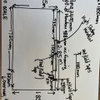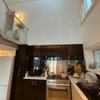Tile cleaning: How to clean tiles?
The tiles and tiles are usually one of the most complicated parts to keep clean and shiny, both on floors, houses, and commercial premises. In fact, cleaning them can be simple in the short term, however, extending this state is already more complicated.

A flat has critical or more critical areas than others, not only for cleaning but also for maintenance in the most hygienic conditions possible. These areas are the kitchen and the bathroom, which have tiling, tiles, and tiles even on the walls.
In the kitchen, residues of grease, odors, and vapors end up removing the shine of the tiles and tiles. In the bathroom, on the other hand, the remains of lime and steam from the water end up reducing the shineand cleanliness of the tiling.
Information
- 1 How can tile and tile be cleaned?
- 1.1 Kitchen tile cleaning
- 1.1.1 Ammonia and water to clean kitchen tiles
- 1.2 Bathroom tile cleaning
- 1.2.1 Cleaning with vinegar and ammonia
- 1.2.2 Cleaning with baking soda
- 1.1 Kitchen tile cleaning
- 2 The most common doubts about tile and tile cleaning
- 2.1 How to remove embedded grease from kitchen tiles?
- 2.2 How to remove limescale embedded in bathroom tiles?
- 2.3 How to clean the blackened joints of the bathroom tiles?
How can tile and tile be cleaned?
kitchen tile cleaning

As has already been mentioned, the kitchen tiles end up full, in large part, of fat from the preparations that are made in them. For this reason, degreasing, acidic, disinfectant products or materials that allow the grease to be easily extracted from the tiles are necessary.
Among the most effective mixes and combinations are the following. Of course, it should be remembered that before using this mixture on the tiles, it will always be convenient to have passed a scourge with neutral soap and water. After rinsing and finishing off the cleaning, the ammonia is perfect and will give shine.
- Hot water and vinegar to clean kitchen tiles and tiles
- The vinegar can be wine, apple, or cleaning. Normally the most effective is usually cleaning, as its composition is much more concentrated and effective in less liquid.
- The way to clean with this mixture is to deposit one part vinegar to two parts hot water in a bucket. Then take a brush and scrub the tiles with this water. You can even apply the vinegar directly to make it more effective and then rinse it off with water.
- To make it much brighter, it is best to give it a last blotting pass with kitchen paper or a chamois that does not leave a trace of fibers.
Ammonia and water to clean kitchen tiles
This mixture is already one of the classics when it comes to cleaning. Three parts water and half ammonia are enough for good results. Detergents or scents can even be made with ammonia.
It is highly effective and practical to use ammonia and hot water to clean kitchen tiles that have been embedded in the dirt for a long time. However, this mixture is very corrosive. That is why it is recommended to use it after having left it to rest for a few moments and with gloves.
bathroom tile cleaning
Bathroom tiles and tiles, as mentioned above, end up full of limescale, steam, and traces of soap, shampoo, and other hygiene products. For this reason, it is important to carry out a series of cleaning habits in order to leave the walls much more beautiful.
Cleaning with vinegar and ammonia
The system is the same as with the cleaning of tiles and tiles in the kitchen. Previously, they must be cleaned with soap and water, but after that, a pass with one of these two mixtures will leave the surface much brighter, disinfected, and cleaner.
Cleaning with baking soda
Mixing baking soda with a little water will not only give the bathroom tiles a shine, but it will also remove excess limescale and protect the area so that these remains do not accumulate so quickly.

The most common questions about tile cleaning
How to remove embedded grease from kitchen tiles?
To do this, the best method is always the mixture of water and ammonia. This combination of products allows fat to be dissolved and extracted, even the most accumulated.
The way to apply it should be either with a sponge or with a scourer, depending on the type of fat and how dry it is. The importance of protecting the hands with rubber gloves should not be forgotten, as this mixture is highly aggressive to the skin due to ammonia.
How to remove limescale embedded in bathroom tiles?
To remove the lucky lime from the tiles of the bathroom, the most useful and economical thing is the mixture of vinegar and water. Above all, yes, the water must be cold.
The application on the surfaces must be done with a sponge, leaving it to act for about ten minutes. When rinsing, it is dried with clean and dry kitchen paper or cloth.
How to clean the blackened joints of the bathroom tiles?
Another common bathroom problem is blackened joints between tile pieces. This is due, in large part, to the moisture in these areas of the floor and not cleaning it properly, which leads to a buildup of mold.
This results not only in an unattractive appearance but also in infections and bacteria. That is why a thorough and thorough cleaning of the bathroom with vinegar, either cleaning or apple vinegar, and hot water is so important. Another very practical product for this problem is baking soda mixed with water.
Both mixtures should be left to act for a few minutes (between 20 and 30) on the surface, after scrubbing the surface with a brush or hard pad. Always protect the hands with gloves, not because of the products themselves, but because of the mold and bacteria on the joints.
Cleaning bathrooms and kitchens, after all, is very simple if you know how to do it. From theSCS Group Integrated Services blog, we want to provide information and advice to our customers and readers to make their lives easier. For more information about our servicesvisit our website






Related Discussions
Balcony Tiles Cleaning
Q
How to effectively clean polished high gloss porcelain tiles.
Q
Will matt-black tiles mean endless cleaning?
Q
Cleaning Travertine Tiles
Q